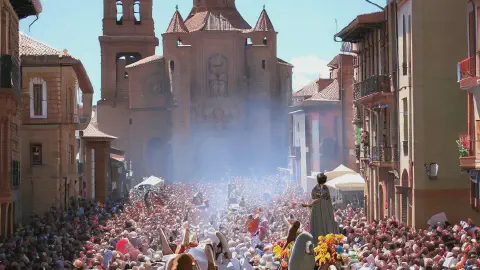
Camino Francés: Belorado to San Juan de Ortega - Stage 11
Posted: | Updated:
Reading time: 14 minutes
Camino Francés: Belorado to San Juan de Ortega - Stage 11
Posted: | Updated:
Reading time: 14 minutes
By: Simon Kemp , Editor
The 24km (15 mile) Belorado to San Juan de Ortega stage begins with a leisurely stroll through flat farmland, moving from Belorado to Tosantos and Villambistia. The route then progresses to hillier terrains, taking pilgrims through the charming village of Espinosa del Camino and the woodland areas around Villafría.
The Camino Francés continues its journey from Belorado, a town with deep medieval roots, to San Juan de Ortega, a secluded hamlet known for its historic monastery. This stage presents a shift in terrain, moving from agricultural plains into the Montes de Oca, a forested region that has challenged pilgrims for centuries.
Historical Background
- Belorado: This town has been inhabited since Roman times and became a fortified frontier settlement under King Alfonso I of Aragon in the 12th century. It was a thriving medieval market town, home to diverse communities of Christians, Jews, and Muslims, each with their own neighborhoods and traditions. The town’s Church of Santa María and the remnants of its castle reflect its history. Belorado was also known for its hermit caves, carved into the cliffs above the town, where monks once lived in solitude.
- San Juan de Ortega: Named after Saint John the Hermit, this tiny settlement is centered around its monastery, founded in the 12th century to aid pilgrims crossing the treacherous Montes de Oca. The monastery’s Romanesque church and cloister remain a place of refuge and reflection for travelers. The saint’s legacy is honored through a unique architectural feature—on the spring and autumn equinoxes, sunlight illuminates a carving of the Annunciation, a phenomenon that has fascinated visitors for centuries.
The Camino Route
The journey from Belorado to San Juan de Ortega spans approximately 24 km and is characterized by:
- Flat farmland in the early stages, passing through Tosantos and Villambistia, where pilgrims encounter small chapels and traditional stone houses.
- A gradual ascent into the Montes de Oca, a dense forested region historically infamous for bandits in the Middle Ages.
- Villafranca Montes de Oca, a village marking the transition into the wooded terrain, where pilgrims can rest before tackling the climb.
- A steady uphill trek through the forest, with sections of rocky paths and occasional clearings offering panoramic views.
- A remote stretch with few services, requiring hikers to carry sufficient water and supplies.
- Arrival at San Juan de Ortega, where the monastery provides a peaceful sanctuary after the demanding walk.
This stage is considered moderately challenging, with a mix of open countryside, forested trails, and elevation gains. Pilgrims often find it to be a contemplative section of the Camino, offering solitude and a deeper connection to the historical pilgrimage experience.
The stage concludes with a challenging uphill climb to the peaceful sanctity of San Juan de Ortega, known for its dedicated monastery. As this is also a popular local route, I have included instructions on how to make the journey by bus from Belorado.
Map of Belorado to San Juan de Ortega Route
Route Description: Belorado to San Juan de Ortega
Stage Distance: Approximately 24 kilometers (15 miles)
A. Detailed Breakdown of the Route
- Belorado to Tosantos (6.8 km, 4.2 miles): Leaving Belorado, the Camino winds through flat farmland, following a path parallel to the road to Tosantos.
- Tosantos to Villambistia (2.5 km, 1.5 miles): From Tosantos, the route continues through more farmland, leading to the small village of Villambistia.
- Villambistia to Espinosa del Camino (3.5 km, 2.1 miles): After Villambistia, the Camino heads towards the hillside village of Espinosa del Camino.
- Espinosa del Camino to Villafría (4.2 km, 2.6 miles): The trail continues uphill through forested paths to Villafría.
- Villafría to San Juan de Ortega (7 km, 4.3 miles): The final stretch of this stage is a steady climb through beautiful woodland before reaching San Juan de Ortega.
B. Terrain and Elevation
The terrain varies in this stage, starting with flat farmland and transitioning into hilly woodland. The path is mostly dirt and gravel, with some sections of road walking.
C. Highlights
Belorado: A charming village with its beautiful churches and a cliffside filled with hermitage caves.
Tosantos: Home to a cave-church dedicated to the Virgin Mary.
San Juan de Ortega: Known for its monastery dedicated to Saint John the Hermit.
D. Potential Challenges
The main challenge in this stage is the steady uphill climb towards San Juan de Ortega, which can be physically demanding. Also, depending on the weather, some paths may be muddy.
E. Rest Stops
There are several small towns along the route where you can rest, grab a snack, and refill your water bottle. These include Tosantos, Villambistia, and Villafría.
Departure Point: Belorado
Belorado, situated in the picturesque landscape of northern Spain, invites you to experience its captivating blend of history, natural beauty, and warm hospitality. This stage of the Camino Francés takes approximately 5-7 hours to walk and covers a distance of 24 kilometers. The route consists mostly of flat terrain and passes through beautiful countryside and charming villages.
Location and History
Belorado is situated in the province of Burgos, within the Castilla y León region. As a vital stop along the renowned Camino de Santiago pilgrimage route, the town has welcomed countless pilgrims throughout the centuries. Its streets and landmarks bear witness to the footsteps of those who have embarked on this sacred journey.
Points of Interest
Travelling from Grañón to Belorado, one notices a collection of remarkable attractions that highlight the region’s rich history and heritage. The awe-inspiring Church of Santa María in Belorado, a stunning example of Gothic architecture from the 14th century, stands tall as a testament to the town’s legacy. Its intricate design and breathtaking stained glass windows captivate visitors with their timeless beauty. The medieval Bridge of San Antón, spanning the Tirón River, serves as a poignant reminder of Belorado’s history as a crossing point for pilgrims.
Natural Surroundings
Embraced by rolling hills, Belorado is a haven for nature enthusiasts seeking tranquility. The idyllic countryside offers mesmerizing hiking trails that beckon exploration. The nearby Montes de Oca mountain range, with its lush forests and babbling streams, offers a serene retreat where you can reconnect with nature and find solace.
Pilgrim Services
Belorado, a popular stop on the Camino de Santiago, caters to the needs of pilgrims with its range of essential services. The town provides a variety of accommodation options, including comfortable hostels and guesthouses, offering a welcoming respite for weary travelers. Local restaurants and cafes serve delightful regional cuisine, providing nourishment and a taste of the local flavors. Meanwhile, shops cater to pilgrims’ needs, supplying essential supplies and keepsakes to commemorate their pilgrimage.
Local Festivals and Traditions
Belorado celebrates its vibrant cultural heritage through exuberant festivals and cherished traditions. The Fiesta de San Pedro, a lively event held in honor of the town’s patron saint, immerses you in the infectious energy of the community. From traditional music to spirited dances and colorful religious processions, these festivities offer a glimpse into the town’s authentic spirit and cultural pride.

Taking the Bus from Belorado to San Juan de Ortega
As one of the most popular and efficient means of transportation in Spain, bus travel offers a cost-effective and scenic route between these two delightful destinations. This article provides a step-by-step guide for those planning to travel by bus from Belorado to San Juan de Ortega.
Getting to the Bus Station in Belorado
The bus station in Belorado, known for its accessibility and central location, is situated in the heart of the town, close to the intersection of Calle Mayor and Calle Emilio Serrano. If you’re staying in or near the town center, reaching the bus station by foot is often the most convenient option. The town’s grid layout and pedestrian-friendly streets make for an easy and enjoyable walk.
For those with luggage or those who prefer a quicker ride, taxis provide a convenient mode of transportation. Taxis in Belorado are known for their punctuality and can be hailed on the streets or booked in advance using a local taxi service such as Radio Taxi Belorado. For the more eco-conscious or adventurous, the town’s bike-friendly paths provide a unique way to reach the bus station.
Once at the bus station, you’ll find several amenities designed to ensure a comfortable start to your journey. The station boasts a spacious waiting area with seating, ideal for resting before the bus arrives. Clean restrooms are available for use, and the ticket office offers services ranging from ticket purchases to inquiries about bus schedules and routes. There’s also a small café adjacent to the station, perfect for grabbing a quick snack or a cup of coffee before your trip.
The Journey from Belorado to San Juan de Ortega
The journey from Belorado to San Juan de Ortega is a showcase of the breathtaking scenery of rural Spain. Meandering through a route that touches the Sierra de la Demanda mountain range and rolling farmlands, the trip provides a feast for the eyes, making the approximately one-hour travel time fly by.
Comfort is a priority for the bus services operating this route. For instance, ALSA buses typically feature reclining seats with ample legroom, individual reading lights, and overhead storage compartments. Most buses also come equipped with a restroom located at the rear of the vehicle.
Your luggage will usually be stored in the undercarriage of the bus. It’s important to note that many bus companies have a luggage allowance policy. As an example, ALSA permits one free piece of luggage per passenger, up to 30kg, and charges a small fee for additional or oversized items.
Delays can occasionally occur due to unforeseen circumstances like road construction or heavy traffic. However, bus companies often communicate any potential delays or changes in schedule through their mobile app or onboard announcements.
Arriving in San Juan de Ortega
The arrival in San Juan de Ortega is the start of your exploration of this historic village. The bus station, although smaller in comparison to other cities, is equipped with essential facilities. A small waiting area provides shelter, and a public restroom is available for passengers.
Located just off the main road, Avenida de Logroño, the bus station is within walking distance of many of San Juan de Ortega’s attractions. A short stroll will take you to the iconic Monastery of San Juan de Ortega, a must-visit site known for its architectural beauty and history.
Taxis are usually available near the bus station. These can be a good option if you’re carrying heavy luggage or if your accommodation isn’t within walking distance. Keep in mind that San Juan de Ortega is a small village, and taxi availability may be limited during off-peak hours.
Local maps of San Juan de Ortega, often displayed at the bus station, are handy resources to help you orient yourself and plan your itinerary. Digital maps are also available via various travel apps, and can offer real-time navigation, points of interest, and even restaurant recommendations.
San Juan de Ortega’s compact size and the warm hospitality of its residents make it an enjoyable destination for travelers who appreciate a slower pace and an intimate connection with local culture. Your journey
Duration and Stopping Points
The bus journey from Belorado to San Juan de Ortega, under ideal conditions, takes approximately 1 hour to 1 hour and 30 minutes. This travel time, however, can be affected by various factors such as traffic conditions, weather, and the specific timing of the bus service chosen. Buses often run on a schedule with multiple daily services, allowing travelers flexibility in choosing a departure time that best suits their itinerary.
The direct route from Belorado to San Juan de Ortega is relatively straightforward and doesn’t typically include many stops. However, depending on the specific bus service you choose, there may be brief stops in small towns or villages along the way. These stopping points usually allow for the pickup and drop-off of passengers, and the exact locations can vary based on the route and time of the bus service. Please note, these are not typically rest stops, and passengers are generally expected to remain on the bus.
The bus route from Belorado to San Juan de Ortega may include stops at several small towns or villages depending on the specific service and time. The following are common stopping points along this route:
- Villafranca Montes de Oca – Known for its captivating landscapes and the remarkable Iglesia de Santiago Apóstol, this town is a typical stop on the journey, offering a brief taste of Spain’s rural charm.
- Ages – This small village, with its quaint houses and welcoming community, is another common stop on the route, offering a glimpse into the serene pace of life in Spain’s countryside.
Please note that the specific stopping points can vary and it’s always recommended to check the exact route of your chosen bus service when purchasing your ticket.
Destination: San Juan de Ortega
San Juan de Ortega, situated in the breathtaking landscapes of northern Spain, offers a captivating blend of history, spirituality, and natural beauty.
Location and History: San Juan de Ortega
Located in the province of Burgos, San Juan de Ortega enchants visitors with its serene setting along the Camino de Santiago pilgrimage route. The town is named after the revered medieval saint, San Juan de Ortega, who played a significant role in the development of the Camino de Santiago. Pilgrims have passed through this town for centuries, following in the footsteps of those seeking spiritual enlightenment.
San Juan de Ortega’s historical importance can be traced back to the 12th century when the saint himself, a skilled architect and benefactor, constructed the Iglesia de San Juan de Ortega. This Romanesque church stands as a testament to the town’s rich heritage and showcases exquisite architectural details that have withstood the test of time. Pilgrims from around the world pause here to pay homage to San Juan de Ortega and seek solace in the tranquil atmosphere.
Points of Interest: San Juan de Ortega
San Juan de Ortega boasts notable points of interest that reflect its historical and spiritual significance. The Iglesia de San Juan de Ortega, with its stone facade and graceful arches, invites visitors to explore its interior adorned with delicate artwork and religious iconography. The dimly lit sanctuary provides a sacred space for contemplation and reflection.
Adjacent to the church, the Monastery of San Juan de Ortega offers pilgrims a place of rest and solace along their journey. Originally built to accommodate weary travelers, the monastery continues to welcome pilgrims, providing basic facilities for rest and spiritual nourishment. Its tranquil cloister and peaceful courtyard offer a retreat from the hustle and bustle of the pilgrimage, allowing pilgrims to rejuvenate their spirits.

Pilgrim Hospitality: San Juan de Ortega
As a vital stop on the Camino de Santiago, San Juan de Ortega extends its warm hospitality to weary pilgrims. The town provides essential services, including comfortable albergues (hostels) that offer a place to rest and recharge. Pilgrims find solace in the camaraderie of fellow travelers, sharing stories, meals, and experiences, creating lifelong connections along the pilgrimage route.
The local community in San Juan de Ortega embodies the spirit of hospitality, embracing pilgrims with open arms. Volunteers and residents offer assistance and support, ensuring that pilgrims feel welcomed and cared for during their stay. The kindness and generosity of the locals leave a lasting impression on pilgrims, fostering a sense of community and reinforcing the spiritual journey.
Natural Beauty
Surrounded by breathtaking landscapes, San Juan de Ortega offers a tranquil retreat for nature lovers. The town is situated amidst rolling hills, lush forests, and picturesque meadows, providing an idyllic backdrop for relaxation and contemplation. The peacefulness of the countryside and the harmony of nature create a serene atmosphere that resonates with pilgrims and visitors alike.
The nearby Montes de Oca mountain range presents an opportunity for exploration, with its scenic hiking trails that wind through dense forests and along babbling streams. Pilgrims can immerse themselves in the beauty of nature, enjoying the healing effects of fresh air and scenic vistas. This connection with nature enhances the pilgrimage experience, offering moments of reflection and introspection.
Spiritual Significance
San Juan de Ortega holds deep spiritual significance for pilgrims and those seeking a connection to their faith. The town is known for the Miracle of the Light, a legendary event where San Juan de Ortega, in an act of divine intervention, miraculously provided light for a pilgrim in need. This miracle has become a symbol of hope and inspiration for those embarking on the Camino de Santiago pilgrimage.
Pilgrims visiting San Juan de Ortega often pause at the Capilla de la Virgen de la Peña, a small chapel where they offer prayers and seek spiritual guidance. The chapel’s peaceful atmosphere and sacred relics create a space for introspection and devotion. The pilgrimage journey, combined with the town’s spiritual significance, deepens the pilgrims’ connection to their faith and reinforces the transformative power of the Camino de Santiago.
Gather yourself in this town as you prepare for the next stage of your journey from San Juan de Ortega to Burgos.
Belorado to San Juan de Ortega [Video]
Already signed up? Go to Camino Downloads!

